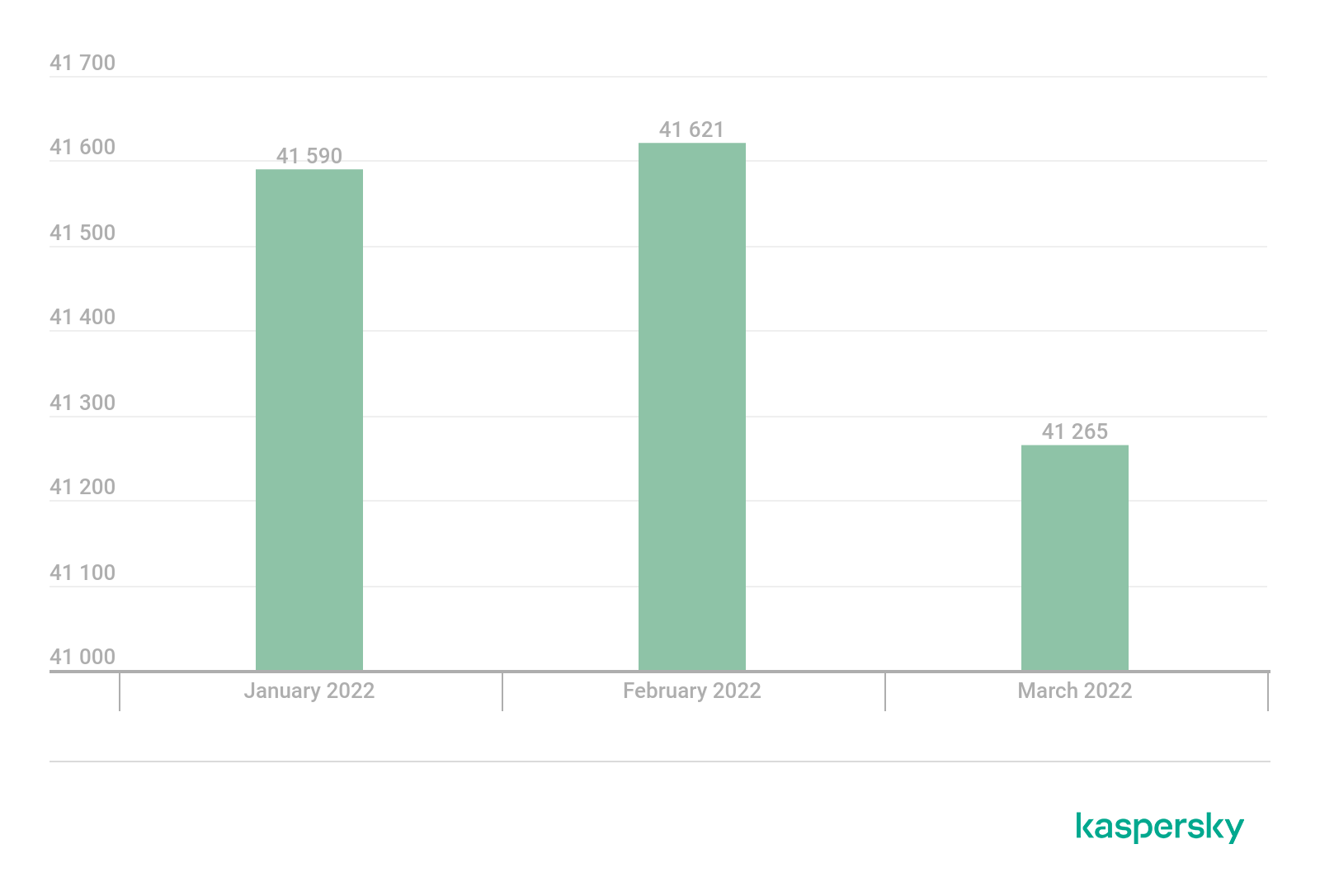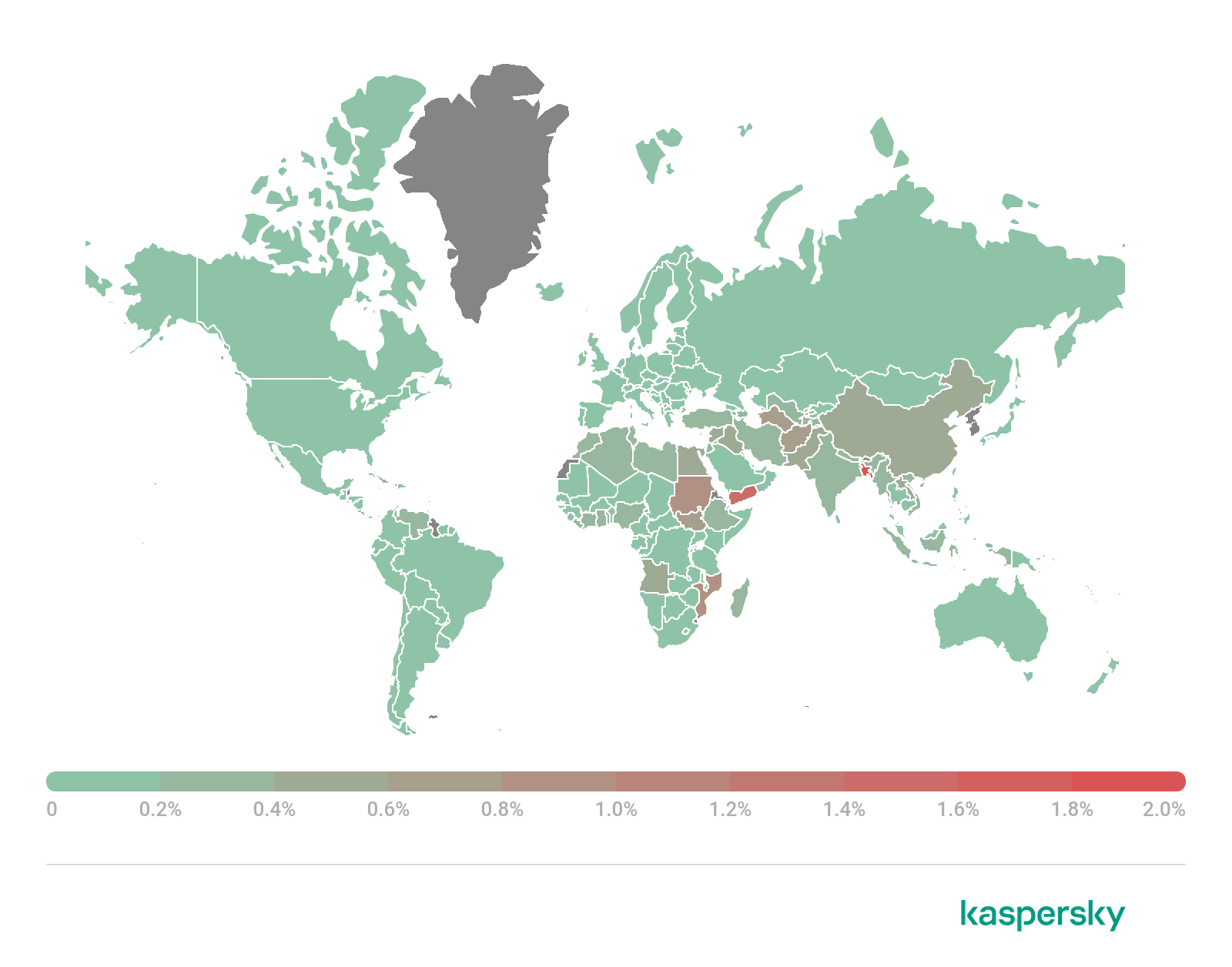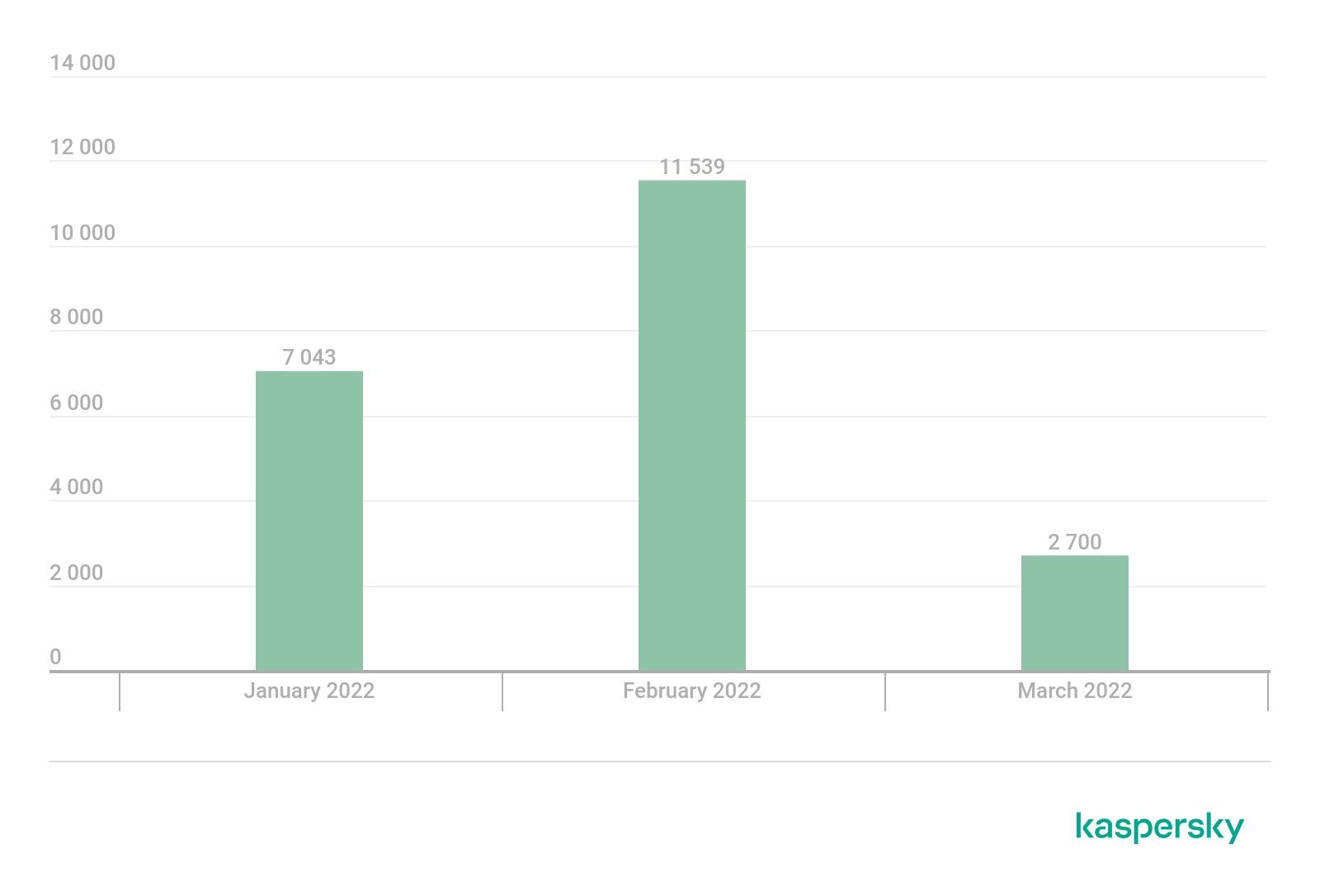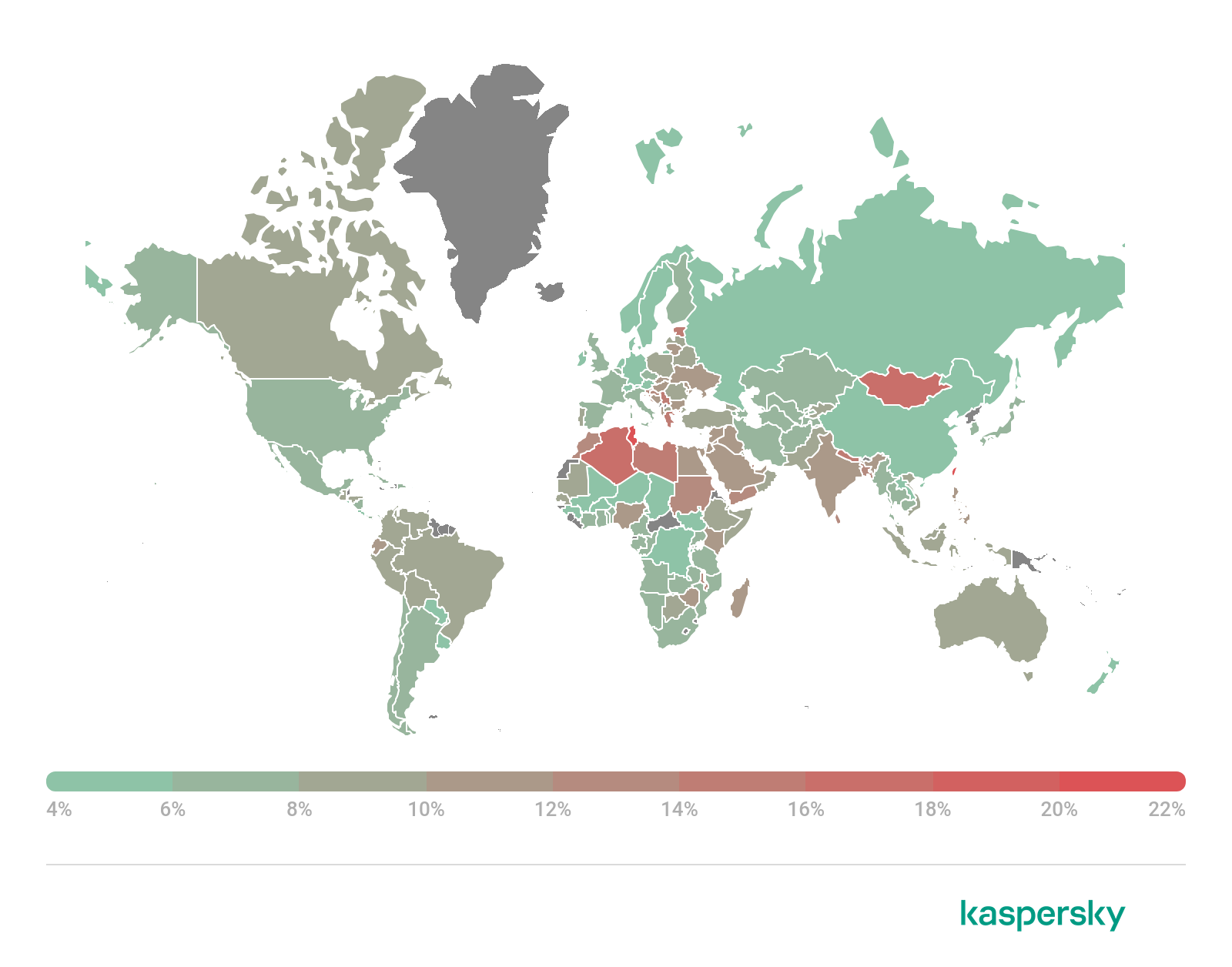
- IT threat evolution in Q1 2022
- IT threat evolution in Q1 2022. Non-mobile statistics
- IT threat evolution in Q1 2022. Mobile statistics
These statistics are based on detection verdicts of Kaspersky products and services received from users who consented to providing statistical data.
Quarterly figures
According to Kaspersky Security Network, in Q1 2022:
- Kaspersky solutions blocked 1,216,350,437 attacks from online resources across the globe.
- Web Anti-Virus recognized 313,164,030 unique URLs as malicious.
- Attempts to run malware for stealing money from online bank accounts were stopped on the computers of 107,848 unique users.
- Ransomware attacks were defeated on the computers of 74,694 unique users.
- Our File Anti-Virus detected 58,989,058 unique malicious and potentially unwanted objects.
Financial threats
Financial threat statistics
In Q1 2022 Kaspersky solutions blocked the launch of at least one piece of malware designed to steal money from bank accounts on the computers of 107,848 unique users.

Number of unique users attacked by financial malware, Q1 2022 (download)
Geography of financial malware attacks
To evaluate and compare the risk of being infected by banking Trojans and ATM/POS malware worldwide, for each country and territory we calculated the share of users of Kaspersky products who faced this threat during the reporting period as a percentage of all users of our products in that country or territory.

Geography of financial malware attacks, Q1 2022 (download)
| Country* | %** | |
| 1 | Turkmenistan | 4.5 |
| 2 | Afghanistan | 4.0 |
| 3 | Tajikistan | 3.9 |
| 4 | Yemen | 2.8 |
| 5 | Uzbekistan | 2.4 |
| 6 | China | 2.2 |
| 7 | Azerbaijan | 2.0 |
| 8 | Mauritania | 2.0 |
| 9 | Sudan | 1.8 |
| 10 | Syria | 1.8 |
* Excluded are countries with relatively few Kaspersky product users (under 10,000).
** Unique users whose computers were targeted by financial malware as a percentage of all unique users of Kaspersky products in the country.
TOP 10 banking malware families
| Name | Verdicts | %* | |
| 1 | Ramnit/Nimnul | Trojan-Banker.Win32.Ramnit | 36.5 |
| 2 | Zbot/Zeus | Trojan-Banker.Win32.Zbot | 16.7 |
| 3 | CliptoShuffler | Trojan-Banker.Win32.CliptoShuffler | 6.7 |
| 4 | SpyEye | Trojan-Spy.Win32.SpyEye | 6.3 |
| 5 | Gozi | Trojan-Banker.Win32.Gozi | 5.2 |
| 6 | Cridex/Dridex | Trojan-Banker.Win32.Cridex | 3.5 |
| 7 | Trickster/Trickbot | Trojan-Banker.Win32.Trickster | 3.3 |
| 8 | RTM | Trojan-Banker.Win32.RTM | 2.7 |
| 9 | BitStealer | Trojan-Banker.Win32.BitStealer | 2.2 |
| 10 | Danabot | Trojan-Banker.Win32.Danabot | 1.8 |
* Unique users who encountered this malware family as a percentage of all users attacked by financial malware.
Our TOP 10 leader changed in Q1: the familiar ZeuS/Zbot (16.7%) dropped to second place and Ramnit/Nimnul (36.5%) took the lead. The TOP 3 was rounded out by CliptoShuffler (6.7%).
Ransomware programs
Quarterly trends and highlights
Law enforcement successes
- Several members of the REvil ransomware crime group were arrested by Russian law enforcement in January. The Russian Federal Security Service (FSB) says it seized the following assets from the cybercriminals: “more than 426 million rubles ($5.6 million) including denominated in cryptocurrency; $600,000; 500,000 euros; computer equipment, the crypto wallets that were used to perpetrate crimes, and 20 luxury cars that were purchased with illicitly obtained money.”
- In February, a Canadian citizen was sentenced to 6 years and 8 months in prison for involvement in NetWalker ransomware attacks (also known as Mailto ransomware).
- In January, Ukrainian police arrested a ransomware gang who delivered an unclarified strain of malware via e-mail. According to the statement released by the police, over fifty companies in the United States and Europe were attacked by the cybercriminals.
HermeticWiper, HermeticRansom and RUransom, etc.
In February, new malware was discovered which carried out attacks with the aim of destroying files. Two pieces of malware — a Trojan called HermeticWiper that destroys data and a cryptor called HermeticRansom — were both used in cyberattacks in Ukraine. That February, Ukrainian systems were attacked by another Trojan called IsaacWiper, followed by a third Trojan in March called CaddyWiper. The apparent aim of this malware family was to render infected computers unusable leaving no possibility of recovering files.
An intelligence team later discovered that HermeticRansom only superficially encrypts files, and ones encrypted by the ransomware can be decrypted.
RUransom malware was discovered in March, which was created to encrypt files on computers in Russia. The analysis of the malicious code revealed it was developed to wipe data, as RUransom generates keys for all the victim’s encrypted files without storing them anywhere.
Conti source-code leak
The ransomware group Conti had its source code leaked along with its chat logs which were made public. It happened shortly after the Conti group expressed support for the Russian government’s actions on its website. The true identity of the individual who leaked the data is currently unknown. According to different versions, it could have been a researcher or an insider in the group who disagrees with its position.
Whoever it may have been, the leaked ransomware source codes in the public domain will obviously be at the fingertips of other cybercriminals, which is what happened on more than one occasion with examples like Hidden Tear and Babuk.
Attacks on NAS devices
Network-attached storage (NAS) devices continue to be targeted by ransomware attacks. A new wave of Qlocker Trojan infections on QNAP NAS devices occurred in January following a brief lull which lasted a few months. A new form of ransomware infecting QNAP NAS devices also appeared in the month of January called DeadBolt, and ASUSTOR devices became its new target in February.
Maze Decryptor
Master decryption keys for Maze, Sekhmet and Egregor ransomware were made public in February. The keys turned out to be authentic and we increased our support to decrypt files encrypted by these infamous forms of ransomware in our RakhniDecryptor utility. The decryptor is available on the website of our No Ransom project and the website of the international NoMoreRansom project in the Decryption Tools section.
Number of new modifications
In Q1 2022, we detected eight new ransomware families and 3083 new modifications of this malware type.

Number of new ransomware modifications, Q1 2021 — Q1 2022 (download)
Number of users attacked by ransomware Trojans
In Q1 2022, Kaspersky products and technologies protected 74,694 users from ransomware attacks.

Number of unique users attacked by ransomware Trojans, Q1 2022 (download)
Geography of attacked users

Geography of attacks by ransomware Trojans, Q1 2022 (download)
TOP 10 countries attacked by ransomware Trojans
| Country* | %** | |
| 1 | Bangladesh | 2.08 |
| 2 | Yemen | 1.52 |
| 3 | Mozambique | 0.82 |
| 4 | China | 0.49 |
| 5 | Pakistan | 0.43 |
| 6 | Angola | 0.40 |
| 7 | Iraq | 0.40 |
| 8 | Egypt | 0.40 |
| 9 | Algeria | 0.36 |
| 10 | Myanmar | 0.35 |
* Excluded are countries with relatively few Kaspersky users (under 50,000).
** Unique users whose computers were attacked by Trojan encryptors as a percentage of all unique users of Kaspersky products in the country.
TOP 10 most common families of ransomware Trojans
| Name | Verdicts* | Percentage of attacked users** | |
| 1 | Stop/Djvu | Trojan-Ransom.Win32.Stop | 24.38 |
| 2 | WannaCry | Trojan-Ransom.Win32.Wanna | 13.71 |
| 3 | (generic verdict) | Trojan-Ransom.Win32.Gen | 9.35 |
| 4 | (generic verdict) | Trojan-Ransom.Win32.Phny | 7.89 |
| 5 | (generic verdict) | Trojan-Ransom.Win32.Encoder | 5.66 |
| 6 | (generic verdict) | Trojan-Ransom.Win32.Crypren | 4.07 |
| 7 | (generic verdict) | Trojan-Ransom.Win32.CryFile | 3.72 |
| 8 | PolyRansom/VirLock | Trojan-Ransom.Win32.PolyRansom / Virus.Win32.PolyRansom | 3.37 |
| 9 | (generic verdict) | Trojan-Ransom.Win32.Crypmod | 3.17 |
| 10 | (generic verdict) | Trojan-Ransom.Win32.Agent | 1.99 |
* Statistics are based on detection verdicts of Kaspersky products. The information was provided by Kaspersky product users who consented to provide statistical data.
** Unique Kaspersky users attacked by specific ransomware Trojan families as a percentage of all unique users attacked by ransomware Trojans.
Miners
Number of new miner modifications
In Q1 2022, Kaspersky solutions detected 21,282 new modifications of miners.

Number of new miner modifications, Q1 2022 (download)
Number of users attacked by miners
In Q1, we detected attacks using miners on the computers of 508,449 unique users of Kaspersky products and services worldwide.

Number of unique users attacked by miners, Q1 2022 (download)
Geography of miner attacks

Geography of miner attacks, Q1 2022 (download)
| Country* | %** | |
| 1 | Ethiopia | 3.01 |
| 2 | Tajikistan | 2.60 |
| 3 | Rwanda | 2.45 |
| 4 | Uzbekistan | 2.15 |
| 5 | Kazakhstan | 1.99 |
| 6 | Tanzania | 1.94 |
| 7 | Ukraine | 1.83 |
| 8 | Pakistan | 1.79 |
| 9 | Mozambique | 1.69 |
| 10 | Venezuela | 1.67 |
* Excluded are countries with relatively few users of Kaspersky products (under 50,000).
** Unique users attacked by miners as a percentage of all unique users of Kaspersky products in the country.
Vulnerable applications used by criminals during cyberattacks
Quarter highlights
In Q1 2022, a number of serious vulnerabilities were found in Microsoft Windows and its components. More specifically, the vulnerability CVE-2022-21882 was found to be exploited by an unknown group of cybercriminals: a “type confusion” bug in the win32k.sys driver the attacker can use to gain system privileges. Also worth noting is CVE-2022-21919, a vulnerability in the User Profile Service which makes it possible to elevate privileges, along with CVE-2022-21836, which can be used to forge digital certificates.
One of the major talking points in Q1 was an exploit that targeted the CVE-2022-0847 vulnerability in the Linux OS kernel. It was dubbed “Dirty Pipe”. Researchers discovered an “uninitialized memory” vulnerability when analyzing corrupted files, which makes it possible to rewrite a part of the OS memory, namely page memory that contains system files’ data. This in turn opens up an opportunity, such as elevating attacker’s privileges to root. It’s worth noting that this vulnerability is fairly easy to exploit, which means users of all systems should regularly install security patches and use all available means to prevent infection.
When it comes to network threats, this quarter continued to show how cybercriminals often resort to the technique of brute-forcing passwords to gain unauthorized access to various network services, the most popular of which are MSSQL, RDP and SMB. Attacks using the EternalBlue, EternalRomance and similar exploits remain as popular as ever. Due to widespread unpatched versions of Microsoft Exchange Server, networks often fall victim to exploits of ProxyToken, ProxyShell, ProxyOracle and other vulnerabilities. One example of a critical vulnerability found is remote code execution (RCE) in the Microsoft Windows HTTP protocol stack which allows an attack to be launched remotely by sending a special network packet to a vulnerable system by means of the HTTP trailer functionality. New attacks on network applications which will probably also become common are RCE attacks on the popular Spring Framework and Spring Cloud Gateway. Specific examples of vulnerabilities in these applications are CVE-2022-22965 (Spring4Shell) and CVE-2022-22947.
Vulnerability statistics
Q1 2022 saw an array of changes in the statistics on common vulnerability types. For instance, the top place in the statistics is still firmly held by exploits targeting vulnerabilities in Microsoft Office and their share has increased significantly to 78.5%. The same common vulnerabilities we’ve written about on more than one occasion are still the most widely exploited within this category of threats. These are CVE-2017-11882 and CVE-2018-0802, which cause a buffer overflow when processing objects in a specially crafted document in the Equation Editor component and ultimately allow an attacker to execute arbitrary code. There’s also CVE-2017-8570, where opening a specially crafted file with an affected version of Microsoft Office software gives attackers the opportunity to perform various actions on the vulnerable system. Another vulnerability found last year which is very popular with cybercriminals is CVE-2021-40444, which they can use to exploit through a specially prepared Microsoft Office document with an embedded malicious ActiveX control for executing arbitrary code in the system.

Distribution of exploits used by cybercriminals, by type of attacked application, Q1 2022 (download)
- CVE-2022-1096: a “type confusion” vulnerability in the V8 script engine which gives attackers the opportunity to remotely execute code (RCE) in the context of the browser’s security sandbox.
- CVE-2022-0609: a use-after-free vulnerability which allows to corrupt the process memory and remotely execute arbitrary codes when performing specially generated scripts that use animation.
Similar vulnerabilities were found in the browser’s other components: CVE-2022-0605which uses Web Store API, and CVE-2022-0606 which is associated with vulnerabilities in the WebGL backend (ANGLE). Another vulnerability found was CVE-2022-0604, which can be used to exploit a heap buffer overflow in Tab Groups, also potentially leading to remote code execution (RCE).
Exploits for Android came third in our statistics (4.10%), followed by exploits targeting the Adobe Flash Platform (3.49%), PDF files (3.48%) and Java apps (2.79%).
Attacks on macOS
The year began with a number of interesting multi-platform finds: the Gimmick multi-platform malware family with Windows and macOS variants that uses Google Drive to communicate with the C&C server, along with the SysJoker backdoor with versions tailored for Windows, Linux and macOS.
TOP 20 threats for macOS
| Verdict | %* | |
| 1 | AdWare.OSX.Pirrit.ac | 13.23 |
| 2 | AdWare.OSX.Pirrit.j | 12.05 |
| 3 | Monitor.OSX.HistGrabber.b | 8.83 |
| 4 | AdWare.OSX.Pirrit.o | 7.53 |
| 5 | AdWare.OSX.Bnodlero.at | 7.41 |
| 6 | Trojan-Downloader.OSX.Shlayer.a | 7.06 |
| 7 | AdWare.OSX.Pirrit.aa | 6.75 |
| 8 | AdWare.OSX.Pirrit.ae | 6.07 |
| 9 | AdWare.OSX.Cimpli.m | 5.35 |
| 10 | Trojan-Downloader.OSX.Agent.h | 4.96 |
| 11 | AdWare.OSX.Pirrit.gen | 4.76 |
| 12 | AdWare.OSX.Bnodlero.bg | 4.60 |
| 13 | AdWare.OSX.Bnodlero.ax | 4.45 |
| 14 | AdWare.OSX.Agent.gen | 3.74 |
| 15 | AdWare.OSX.Agent.q | 3.37 |
| 16 | Backdoor.OSX.Twenbc.b | 2.84 |
| 17 | Trojan-Downloader.OSX.AdLoad.mc | 2.81 |
| 18 | Trojan-Downloader.OSX.Lador.a | 2.81 |
| 19 | AdWare.OSX.Bnodlero.ay | 2.81 |
| 20 | Backdoor.OSX.Agent.z | 2.56 |
* Unique users who encountered this malware as a percentage of all users of Kaspersky security solutions for macOS who were attacked.
The TOP 20 threats to users detected by Kaspersky security solutions for macOS is usually dominated by various adware apps. The top two places in the rating were taken by adware apps from the AdWare.OSX.Pirrit family, while third place was taken by a member of the Monitor.OSX.HistGrabber.b family of potentially unwanted software which sends users’ browser history to its owners’ servers.
Geography of threats for macOS

Geography of threats for macOS, Q1 2022 (download)
| Country* | %** | |
| 1 | France | 2.36 |
| 2 | Spain | 2.29 |
| 3 | Italy | 2.16 |
| 4 | Canada | 2.15 |
| 5 | India | 1.95 |
| 6 | United States | 1.90 |
| 7 | Russian Federation | 1.83 |
| 8 | United Kingdom | 1.58 |
| 9 | Mexico | 1.49 |
| 10 | Australia | 1.36 |
* Excluded from the rating are countries with relatively few users of Kaspersky security solutions for macOS (under 10,000).
** Unique users attacked as a percentage of all users of Kaspersky security solutions for macOS in the country.
In Q1 2022, the country where the most users were attacked was France (2.36%), followed by Spain (2.29%) and Italy (2.16%). Adware from the Pirrit family was encountered most frequently out of all macOS threats in the listed countries.
IoT attacks
IoT threat statistics
In Q1 2022, most devices that attacked Kaspersky traps did so using the Telnet protocol as before. Just one quarter of devices attempted to brute-force our SSH traps.
| Telnet | 75.28% |
| SSH | 24.72% |
Distribution of attacked services by number of unique IP addresses of devices that carried out attacks, Q1 2022
If we look at sessions involving Kaspersky honeypots, we see far greater Telnet dominance.
| Telnet | 93.16% |
| SSH | 6.84% |
Distribution of cybercriminal working sessions with Kaspersky traps, Q1 2022
TOP 10 threats delivered to IoT devices via Telnet
| Verdict | %* | |
| 1 | Backdoor.Linux.Mirai.b | 38.07 |
| 2 | Trojan-Downloader.Linux.NyaDrop.b | 9.26 |
| 3 | Backdoor.Linux.Mirai.ba | 7.95 |
| 4 | Backdoor.Linux.Gafgyt.a | 5.55 |
| 5 | Trojan-Downloader.Shell.Agent.p | 4.62 |
| 6 | Backdoor.Linux.Mirai.ad | 3.89 |
| 7 | Backdoor.Linux.Gafgyt.bj | 3.02 |
| 8 | Backdoor.Linux.Agent.bc | 2.76 |
| 9 | RiskTool.Linux.BitCoinMiner.n | 2.00 |
| 10 | Backdoor.Linux.Mirai.cw | 1.98 |
* Share of each threat delivered to infected devices as a result of a successful Telnet attack out of the total number of delivered threats.
Similar IoT-threat statistics are published in the DDoS report for Q1 2022.
Attacks via web resources
The statistics in this section are based on Web Anti-Virus, which protects users when malicious objects are downloaded from malicious/infected web pages. Cybercriminals create such sites on purpose and web resources with user-created content (for example, forums), as well as hacked legitimate resources, can be infected.
Countries and territories that serve as sources of web-based attacks: TOP 10
The following statistics show the distribution by country or territory of the sources of Internet attacks blocked by Kaspersky products on user computers (web pages with redirects to exploits, sites hosting malicious programs, botnet C&C centers, etc.). Any unique host could be the source of one or more web-based attacks.
To determine the geographic source of web attacks, the GeoIP technique was used to match the domain name to the real IP address at which the domain is hosted.
In Q1 2022, Kaspersky solutions blocked 1,216,350,437 attacks launched from online resources across the globe. 313,164,030 unique URLs were recognized as malicious by Web Anti-Virus components.

Distribution of web-attack sources by country and territory, Q1 2022 (download)
Countries and territories where users faced the greatest risk of online infection
To assess the risk of online infection faced by users in different countries and territories, for each country or territory we calculated the percentage of Kaspersky users on whose computers Web Anti-Virus was triggered during the quarter. The resulting data provides an indication of the aggressiveness of the environment in which computers operate in different countries and territories.
This rating only includes attacks by malicious programs that fall under the Malware class; it does not include Web Anti-Virus detections of potentially dangerous or unwanted programs such as RiskTool or adware.
| Country or territory* | %** | |
| 1 | Taiwan | 22.63 |
| 2 | Tunisia | 21.57 |
| 3 | Algeria | 16.41 |
| 4 | Mongolia | 16.05 |
| 5 | Serbia | 15.96 |
| 6 | Libya | 15.67 |
| 7 | Estonia | 14.45 |
| 8 | Greece | 14.37 |
| 9 | Nepal | 14.01 |
| 10 | Hong Kong | 13.85 |
| 11 | Yemen | 13.17 |
| 12 | Sudan | 13.08 |
| 13 | Slovenia | 12.94 |
| 14 | Morocco | 12.82 |
| 15 | Qatar | 12.78 |
| 16 | Croatia | 12.53 |
| 17 | Republic of Malawi | 12.33 |
| 18 | Sri Lanka | 12.28 |
| 19 | Bangladesh | 12.26 |
| 20 | Palestine | 12.23 |
* Excluded are countries and territories with relatively few Kaspersky users (under 10,000).
** Unique users targeted by Malware-class attacks as a percentage of all unique users of Kaspersky products in the country or territory.
On average during the quarter, 8.18% of computers of Internet users worldwide were subjected to at least one Malware-class web attack.

Geography of web-based malware attacks, Q1 2022 (download)
Local threats
In this section, we analyze statistical data obtained from the OAS and ODS modules in Kaspersky products. It takes into account malicious programs that were found directly on users’ computers or removable media connected to them (flash drives, camera memory cards, phones, external hard drives), or which initially made their way onto the computer in non-open form (for example, programs in complex installers, encrypted files, etc.).
In Q1 2022, our File Anti-Virus detected 58,989,058 malicious and potentially unwanted objects.
Countries where users faced the highest risk of local infection
For each country, we calculated the percentage of Kaspersky product users on whose computers File Anti-Virus was triggered during the reporting period. These statistics reflect the level of personal computer infection in different countries.
Note that this rating only includes attacks by malicious programs that fall under the Malware class; it does not include File Anti-Virus triggerings in response to potentially dangerous or unwanted programs, such as RiskTool or adware.
| Country* | %** | |
| 1 | Yemen | 48.38 |
| 2 | Turkmenistan | 47.53 |
| 3 | Tajikistan | 46.88 |
| 4 | Cuba | 45.29 |
| 5 | Afghanistan | 42.79 |
| 6 | Uzbekistan | 41.56 |
| 7 | Bangladesh | 41.34 |
| 8 | South Sudan | 39.91 |
| 9 | Ethiopia | 39.76 |
| 10 | Myanmar | 37.22 |
| 11 | Syria | 36.89 |
| 12 | Algeria | 36.02 |
| 13 | Burundi | 34.13 |
| 14 | Benin | 33.81 |
| 15 | Rwanda | 33.11 |
| 16 | Sudan | 32.90 |
| 17 | Tanzania | 32.39 |
| 18 | Kyrgyzstan | 32.26 |
| 19 | Venezuela | 32.00 |
| 20 | Iraq | 31.93 |
* Excluded are countries with relatively few Kaspersky users (under 10,000).
** Unique users on whose computers Malware-class local threats were blocked, as a percentage of all unique users of Kaspersky products in the country.

Geography of local infection attempts, Q1 2022 (download)



















IT threat evolution in Q1 2022. Non-mobile statistics